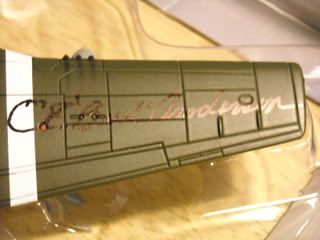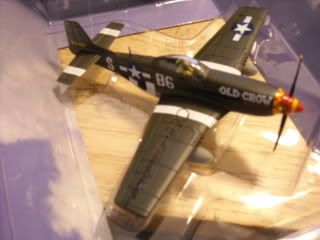Tue Feb 10, 2009 12:59 pm
Gary, I can take care of that for you here, whenever you want to see it I'll email you a picture of it. 
On a serious note that is a GREAT piece to have. As others have said make sure it's behind UV glass and then I would still make sure it's not in direct light.
Mike
On a serious note that is a GREAT piece to have. As others have said make sure it's behind UV glass and then I would still make sure it's not in direct light.
Mike
Tue Feb 10, 2009 2:03 pm
APG85 wrote:Gary,
I would consider taking that to a professional framing place and having it framed. Because of it's condition, they would probably mount it for you (glue it to foam backing board) something you don't want to tackle on your own...
A professional framer will not glue the piece onto foam backing. They should use conservation mounts which will not damage the piece. Do not go to any framer that will use glue for framing the object. Just think about it, would you want glue stuck to any artificats or important historical documents?
Beyond what the others have said, if you are going to store a poster, print, or any paper object, make sure it's stored flat and not rolled in a tube.
Tue Feb 10, 2009 2:05 pm
Thanks for all the hints, y'all. My picture isn't in any direct or reflected light, but I'm pretty sure the glass isn't UV protected. I'll put that on my "to do" list.
Gary
Gary
Tue Feb 10, 2009 2:36 pm
APG85 wrote:retroaviation wrote:I'm interested in how to save the signatures as well. I have this picture that was signed by all of the Lockheed test pilots that flew the XP-38 Lightning, including Tony LeVeir (barely seen in the upper, left corner), and the signatures are seemingly getting more and more faded.
Gary
Gary,
I would consider taking that to a professional framing place and having it framed. Because of it's condition, they would probably mount it for you (glue it to foam backing board) something you don't want to tackle on your own...
Under no circumstance would you ever "dry mount" (described above) a valuable item. Besides possible damage from the adhesive, the process requires excessive heat that can age and or cause bubbling of the item. In this case it could smear/melt the autographs. This is from a company that dry mounts:
http://www.trueart.info/dry_mounting.htm
"The disadvantages of dry mounting are that it is not reversible in some cases and not easily reversible in other cases. If it is reversible, it is not reversible in water. The high temperatures often attained in dry mounting may cause bubbling and may prematurely age photographs as well as scorch fabrics. Dry mounting is not generally considered an archival method of mounting."
Tue Feb 10, 2009 3:10 pm
kzollitsch wrote:APG85 wrote:Gary,
I would consider taking that to a professional framing place and having it framed. Because of it's condition, they would probably mount it for you (glue it to foam backing board) something you don't want to tackle on your own...
A professional framer will not glue the piece onto foam backing. They should use conservation mounts which will not damage the piece. Do not go to any framer that will use glue for framing the object. Just think about it, would you want glue stuck to any artificats or important historical documents?
quote]
If it was an actual print/painting, I would agree. This appears to be a VERY damaged print with tape marks on it. It appears to be brittle and water marked/yellowed. The best thing to do is to take it to a pro and have it evaluated...
Tue Feb 10, 2009 3:54 pm
I had Jeff Mackay sign my Tug at the wotn Air show couple of years ago so I figured Id spray it in clear coat. A sharpie and clear coat are not compatable.
Tue Feb 10, 2009 5:16 pm
Don't put Future or anything else on the Sharpie autographs. I have found that it smears easily.
You have basically two options.
1. Put it away in the dark. Then you can be pretty sure that when you die, it will look just as good as it does now.
2. Keep it out in the light where you can admire it. I favor this option. The autographs of Bader, Galland, Tibbets, Anderson etc. are not rare or very valuable in an economic sense. So enjoy them! Even out on the coffee table, they'll last longer than you will.
August
You have basically two options.
1. Put it away in the dark. Then you can be pretty sure that when you die, it will look just as good as it does now.
2. Keep it out in the light where you can admire it. I favor this option. The autographs of Bader, Galland, Tibbets, Anderson etc. are not rare or very valuable in an economic sense. So enjoy them! Even out on the coffee table, they'll last longer than you will.
August
Tue Feb 10, 2009 6:08 pm
You need a framer that knows how to do archival framing. I owned an art gallery for years and framed lots of memorabilia. A good framer can help you decide the best way to protect your item. Most importantly, get not just UV glass, but spend the money and get UV conservation glass. That will protect your item from fading. You would still not want to hang it in direct sunlight, but it would be well protected. Sunlight and fluorescents=death to artwork.
Tue Feb 10, 2009 10:30 pm
The B-29 signed by Tibbets and Van Kirk is the similar, except it's in blue ink sharpie. Was funny, Tibbets looked at before he signed it and said: "You know the Real Enola Gay didnt' have turrets!" This is what I have:




Wed Feb 11, 2009 6:01 pm
Hi All!
Most of this was covered, but heres another 2 cents. Maybe it will help.
I have a little experience artwork preservation/conservation kinda stuff. I collect a lot of very old papery kinda things.
With paper, if you're going to store it, have it between two acid free rag mats. The mats can be hinged with acid free tape. The artwork/signature can even be hung inside of these using an acid free type of rice paper and acid free tape making a kind of pocket to put the artwork in inside of the mats. Store it flat.
Another way to store paper based art is to put it in an acid free folio. This isn't as good as the mat solution, but the artwork is always available for viewing. These are available on ebay and elsewhere for a reasonable cost. They come in different sizes and are acid free. You have to pay attention how you handle and store the folio, since the items are loose in them.
The best way I have found to store paper based art is to frame it. Being conservation framed will preserve it and you can look at it. Acid free rag mats, UV glass, Acid free backing(no glueing/dry mounting ), any good conservation framer shoould be able to do it. It costs more, but it is worth it. Take the art off of the wall once or twice a year to make sure the backing is intact and no spiders or other things are trying to live in it.
), any good conservation framer shoould be able to do it. It costs more, but it is worth it. Take the art off of the wall once or twice a year to make sure the backing is intact and no spiders or other things are trying to live in it.
As far as objects, especially plastic ones, it's pretty much the same as paper. No direct sunlight. No Smoking. No Dust, no, no,,,, The best thing I've seen is to keep it in a sealed box and take it out when you want to look at it, and never shellac or coat them. That stuff deteriorates over time destroying the sig and the object. An arcyrilic case or a trophy/china cabinet with a UV glass front works good too.
I keep my paper stuff framed or in a folio now. My plastic kinda things go into a box in the closet or are displayed in a closed cabinet.
Here are pictures of two different sized folios I use. They cost between 15 and 45 dollars. Here is a picture of a conservation framed etching. It cost around 200 dollars to do it. You can spent less if you use one mat and a metal frame.





Most of this was covered, but heres another 2 cents. Maybe it will help.
I have a little experience artwork preservation/conservation kinda stuff. I collect a lot of very old papery kinda things.
With paper, if you're going to store it, have it between two acid free rag mats. The mats can be hinged with acid free tape. The artwork/signature can even be hung inside of these using an acid free type of rice paper and acid free tape making a kind of pocket to put the artwork in inside of the mats. Store it flat.
Another way to store paper based art is to put it in an acid free folio. This isn't as good as the mat solution, but the artwork is always available for viewing. These are available on ebay and elsewhere for a reasonable cost. They come in different sizes and are acid free. You have to pay attention how you handle and store the folio, since the items are loose in them.
The best way I have found to store paper based art is to frame it. Being conservation framed will preserve it and you can look at it. Acid free rag mats, UV glass, Acid free backing(no glueing/dry mounting
As far as objects, especially plastic ones, it's pretty much the same as paper. No direct sunlight. No Smoking. No Dust, no, no,,,, The best thing I've seen is to keep it in a sealed box and take it out when you want to look at it, and never shellac or coat them. That stuff deteriorates over time destroying the sig and the object. An arcyrilic case or a trophy/china cabinet with a UV glass front works good too.
I keep my paper stuff framed or in a folio now. My plastic kinda things go into a box in the closet or are displayed in a closed cabinet.
Here are pictures of two different sized folios I use. They cost between 15 and 45 dollars. Here is a picture of a conservation framed etching. It cost around 200 dollars to do it. You can spent less if you use one mat and a metal frame.





Wed Feb 11, 2009 6:07 pm
Thank you for the tips... I know I've learned a few things.